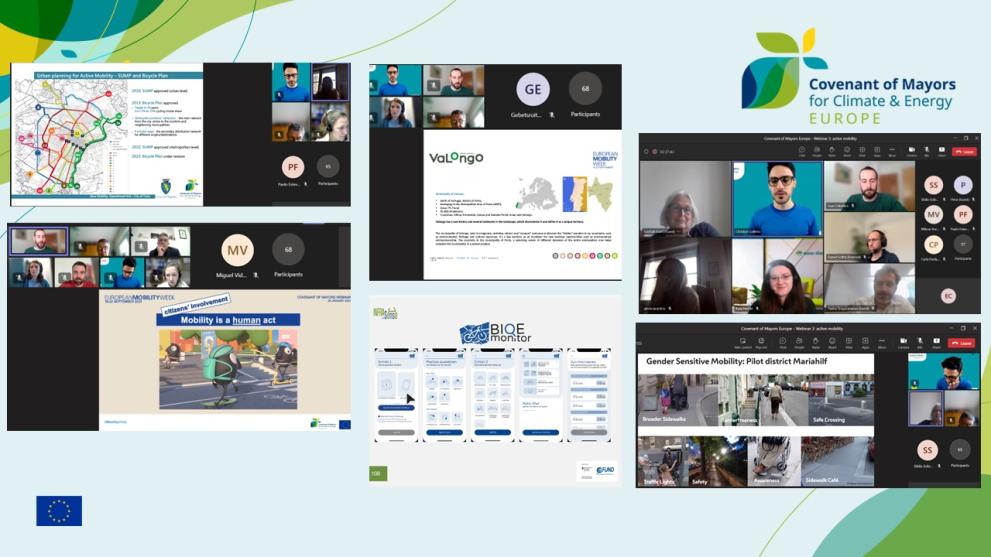
Active mobility, such as cycling and walking, is crucial for reducing greenhouse gas emissions, traffic congestion, and noise in cities, as well as improving air quality and public health. This webinar covered various aspects of urban planning for active mobility, including citizen engagement, the reallocation of car spaces for active mobility, gender-sensitive co-design of active mobility areas, and data-driven monitoring of cycling routes to continually improve policy-making.
The European Mobility Week campaign
The European Mobility Week campaign, presented by Juan Caballero (Campaign manager at Eurocities), has a twofold objective: to invite and encourage people to move more sustainably and to motivate municipal authorities to take measures. After all, “Mobility is a human act, and we need to remember the human side of urban mobility”. After more than 20 years, the campaign still involves thousands of municipalities all around Europe (2989 in 2022) to implement actions about sustainable mobility.
Valongo (PT), shifting in mobility habits through the eyes of the children
Winner of the European Mobility Week Award for smaller municipalities in 2021, Valongo (PT) distinguished itself by integrating public opinion into its green mobility plans through permanent measures and activities, such as theater shows, classes, and surveys to raise awareness. The municipality also sponsored sports events, organized walking-to-school activities, and held car-free days to mobilize children first, and adults as a consequence. As stressed by Paulo Ferreira (Councillor for mobility), the use of tactical urbanism (low-cost easy to-implement solutions, such as paintings on sidewalks), such as sidewalk paintings, was key to overcoming citizens' resistance to change, and promoting cycling and walking.
Re-allocating public spaces for cycling and walking in Turin (IT)
Turin (IT) demonstrated that reallocating public spaces previously dedicated to cars for active mobility is possible. As explained by Gloria Tarantino (Technical Officer), the city invested more than 30 million euros in projects to create cycling highways, car-free zones, and green areas for walking and cycling, after approving its new Sustainable Mobility Plan (SUMP) and revising its Bicycle Plan by 2023. These active mobility projects will enhance the city's resilience to heat islands and floods, reduce noise and air pollution, and boost the local economy.
Gender mainstreaming active mobility in Vienna (AT)
In Vienna, active mobility was made inclusive through the participation of gender-sensitive users, including women, elders, people with disabilities, migrants and children. Some areas were redesigned and co-designed with gender-sensitive participation, as seen in the pilot district of Marihilf. Eva Kail (Gender planning expert), explained how the city built broader sidewalks, barrier-free pavements, and timed traffic lights to accommodate the needs of all active mobility users. To start a gender-sensitive planning process, Eva recommends identifying and mapping user groups and involving them in the co-design process. Vienna has included all its methods in a manual, which is available online.
Data-driven monitoring of cycling routes in Oldenburg (DE)
Oldenburg monitors and analyzes cycling routes through data-driven citizen science projects. The "Ecosense" project, led by Kyra Pelzner (Project coordinator), collected cycling data to optimize the infrastructure of Oldenburg's cycling routes by using sensors integrated into bikes given to 200 participants representative of the city’s population. The subsequent "Infrasense" project, led by Daniel Schlitt (Project coordinator), aims at collecting crowd-sourced data through the sensors and a mobile app, to show the quality of mapped routes in a way accessible to citizens, by allowing them to also provide feedback.
Main Takeaways
- Sustainable urban mobility is a challenge not only for cities, but also for citizens and companies, who should be involved in its enhancement.
- Providing citizens with spaces such as sidewalks, green areas, and cycling routes is crucial for promoting active mobility in cities.
- Tactical urbanism is a powerful tool for promoting active mobility and changing citizens' habits.
- Active mobility users should be involved in the planning process through awareness-raising campaigns, co-design, and data-gathering processes.
- Urban planning should take into account the needs of all active mobility users, including gender-sensitive categories such as women, migrants, elders, people with disabilities, children.
Did you miss our webinar? No worries, here is the recording of the video!
Do you want to follow our next appointments? Dates will soon be available on the Covenant of Mayors’ websites!
Save the date: Next Webinar on Electric Mobility in April 2023!
Λεπτομέρειες
- Ημερομηνία δημοσίευσης
- 6 February 2023
